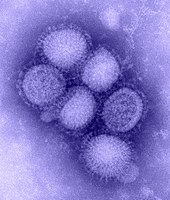The H1N1 virus is a new form of
influenza that first infected the United States in 2009. The H1N1 virus is also known as “swine flu”
because it has very similar genes to a form of influenza that infected North
American pigs, although further study showed it was a different virus spreading
from person to person world-wide. The
virus’s symptoms are similar to that of any form of influenza and include runny
nose, achy body, fever, sore throat, vomiting and the chills. Also people with chronic health issues can see
complications increasing due to H1N1 and can lead to bronchitis or pneumonia in
addition to the flu symptoms.
H1N1
is highly contagious like most forms of the flu and is spread human to human
when germs are spread from sneezing, coughing, or direct contact with a skin or
surface with germs on it and although the pandemic of wide spread swine flu
occurred in September and October of 2009 it has come about in spurts during
the flu season over 2010 and 2011. It is usually treatable without much doctor’s
attention unless complications occur. Certain at risk people like young children
it has a higher risk of death and complications that aren’t normal flu symptoms.
It its less likely for people 65 or older to actually get infected with the
H1N1 as by the age of 65 they may have developed the antibodies but if they do
get infected it can be traumatic even though the numbers show that it effects
middle-aged and young people more severely. In comparison to other influenzas, there
are about 36,000 people who die from other forms of the flu and more than 90%
of those deaths are from people 65 or older, in the flu season of 2009 88% of
deaths were from those younger than 65, according to the Center for Disease
Control (CDC), showing that it has a much more traumatic affect or middle-aged
people than the regular flu which is much more traumatizing to seniors, while
they are more resistant to the H1N1 virus.
There
have been “swine flu parties” where someone who has been infected but had a mild
illness would have people purposely come in contact with and infected with the
disease in order to obtain a less severe form, an immunity to the disease and
maybe an immunity to any forms of the disease that may evolve and could
possibly be a more severe disease, but the CDC called caution against such
events stating that no one could tell what the severity of ones sickness would
be just by comparing it to what who they caught the illness from went
through. Because of the unpredictable
nature of the virus and the fact it can easily be confused with the normal flu
and take a turn for the worst the CDC has encouraged all people 6 months of age
or older to get the H1N1 vaccine to try to quickly halt the chances of another
outbreak.

No comments:
Post a Comment